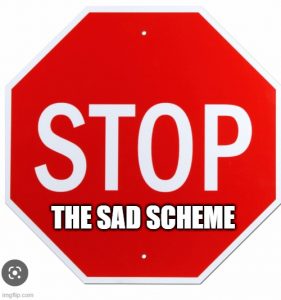Judge Hammers SEC for Lying to Get an Ex Parte TRO–SEC v. Digital Licensing
 As I’ve recently mentioned, ex parte proceedings are error-prone because the judge hears only one side of the story and doesn’t get enough context to spot the possible flaws. This systematic–and avoidable–risk of errors has materially contributed to the SAD Scheme’s success. For example, rightsowners claim that defendants are international, even if they aren’t, and that the defendants’ funds need to restrained because they are at risk of moving to hard-to-reach international bank accounts, even if the defendants are domestic and using domestic banks. Because the judge gives the rightsowners the benefit of the doubt when it’s not deserved, chaos ensues when the rightsowners are inevitably wrong. And shockingly, even when the truth comes out, SAD Scheme judges don’t punish rightsowners for obtaining ex parte TROs based on their misrepresentations. #StopTheSADScheme.
As I’ve recently mentioned, ex parte proceedings are error-prone because the judge hears only one side of the story and doesn’t get enough context to spot the possible flaws. This systematic–and avoidable–risk of errors has materially contributed to the SAD Scheme’s success. For example, rightsowners claim that defendants are international, even if they aren’t, and that the defendants’ funds need to restrained because they are at risk of moving to hard-to-reach international bank accounts, even if the defendants are domestic and using domestic banks. Because the judge gives the rightsowners the benefit of the doubt when it’s not deserved, chaos ensues when the rightsowners are inevitably wrong. And shockingly, even when the truth comes out, SAD Scheme judges don’t punish rightsowners for obtaining ex parte TROs based on their misrepresentations. #StopTheSADScheme.
* * *
It doesn’t have to be that way. Judges need to aggressively police the parties’ litigation conduct and sanction any misconduct, ESPECIALLY when the adjudicatory process deviates from our standard adversarial model of judging. The public’s trust in the judicial system depends on such policing. Today’s case shows how one judge angrily responded to the plaintiff’s overclaims in requesting an ex parte TRO. Why aren’t we seeing similar judicial outrage against SAD Scheme errors?
The case involves cryptocurrency 🙄. The SEC targeted a group of 18 defendants and 10 relief defendants for alleged investor fraud and unregistered activity. The SEC sought an ex parte TRO because the groups were purportedly expatriating and dissipating assets, as evidenced by recently closed bank accounts and public statements that the group was moving to UAE to avoid SEC regulation. At the TRO hearing, the SEC lawyer represented that “in the last 48 hours Defendants have closed additional bank accounts, and I believe the number, I don’t have it in front of me, was around 33 bank accounts have been closed.” The court found this latter fact, indicating an urgent need for intervention, particularly persuasive in issuing a TRO. Spoiler: it wasn’t true. Worse, another SEC attorney in the courtroom knew it was wrong and didn’t correct the error on the spot or afterwards.
When the defendants appeared in court, they corrected the facts. There had not been any bank account closures in the preceding 48 hours. Some of the prior bank account closures had been done by the banks, not the accountholders, and funds had been redeposited in US banks. 24 accounts were closed in total, not 33, and it’s not clear who initiated those closures. Some of the account balances had been drawn down (rather than closed), but other account balances had grown. And the group completed its move to UAE a year earlier, so the public statements didn’t signal some imminent risk of asset flight.
Now, you might classify these errors as standard prosecutor behavior, i.e., prosecutors acting as zealous advocates necessarily misrepresent the facts to tell the narrative they are trying to sell to the courts. Despite the risk of overclaims and misrepresentations inherent in zealous advocacy, many people–including judges and reporters–often give an agency like the SEC the benefit of the doubt. If a government agency makes a fact claim, we should be able to assume it’s true, right? This is a good reminder to ALWAYS read every government press release and complaint with a healthy dose of skepticism that it’s advocacy, not declarations of truth, because the same dynamics that plagued the SEC’s fact claims here apply in those circumstances as well.
In this case, everyone now agrees that the SEC knew the actual facts, misportrayed those facts to the judge, got a TRO it never deserved, and changed its tune only after the defense showed up.
The court was PISSED about this, disparaging the SEC’s explanations of its misclaims as “troubling,” “difficult to accept,” “unsatisfactory,” and “strain[] credulity.” The court says it has “compelling evidence of pervasive abuses of judicial process and subjective bad faith.” The court summarizes:
It is essential to keep the broader context in mind. The Commission came to the court seeking the extraordinary relief of an ex parte TRO together with a sweeping asset freeze and court-appointed receiver to assume control of Defendants’ companies. It expressly traded on its special standing as a federal agency—reminding the court it had been granted this relief several times in the past ten years—to demonstrate it could be trusted when asking for this tremendous exercise of judicial authority. An ex parte TRO is extraordinary relief that requires a fact-based compelling showing of the irreparable harm likely to result if the TRO is not granted. The Commission argued the facts demonstrated this: Defendants were contemporaneously and rapidly shutting down their domestic bank accounts, transferring investor funds in those accounts overseas to place them beyond the reach of the court, and undertaking efforts to obstruct the Commission—suggesting Defendants were aware of the Commission’s investigation. Relying on the Commission’s representations, the court granted the ex parte TRO, froze Defendants’ accounts and other assets, and appointed the requested Receiver. As a result, companies were seized, assets were frozen, and lives were upended.
In the end, once Defendants had notice and an opportunity to respond, each purportedly factual pillar the Commission constructed to make the required showing of irreparable harm crumbled under scrutiny. It was not just a single imprecise statement or inadvertent misstatement. Each piece of support the Commission offered in seeking the TRO—and then later reiterated in defending the TRO—proved to be some combination of false, mischaracterized, and misleading. Further, the Commission not only repeated and affirmed its misrepresentations in the face of contrary evidence, it presented new falsehoods to the court in an effort to subtly shift from its previous misrepresentations without acknowledging its previous errors. The Commission’s conduct demonstrated it knew its representations were false and it was deliberately perpetuating those falsehoods—continuing to abuse the judicial process in defense of the ex parte TRO that should not have issued….
Given the myriad and repeated instances of misconduct, the court cannot write these issues off as non-willful, inadvertent mistakes. Particularly in view of the discrete examples of bad faith conduct the court discusses above, the court can only conclude the Commission made these strategic decisions because it knew if it made clear the tenuous nature of the evidentiary support for its self-described inferences, the court would not issue the TRO and asset freeze the Commission sought.
 Does this sound familiar? Many of these concerns apply verbatim to the SAD Scheme. The rightsowners are sophisticated repeat players who intentionally cut corners on their Rule 11 investigations to save costs, impose significant harms, and then sheepishly acknowledge that it’s impossible to achieve factual accuracy when they are mass-manufacturing litigation. There are good reasons for SAD Scheme judges to respond as angrily to those “mistakes” as this judge responded to the SEC.
Does this sound familiar? Many of these concerns apply verbatim to the SAD Scheme. The rightsowners are sophisticated repeat players who intentionally cut corners on their Rule 11 investigations to save costs, impose significant harms, and then sheepishly acknowledge that it’s impossible to achieve factual accuracy when they are mass-manufacturing litigation. There are good reasons for SAD Scheme judges to respond as angrily to those “mistakes” as this judge responded to the SEC.
Having concluded that the SEC’s “conduct constitutes a gross abuse of the power entrusted to it by Congress and substantially undermined the integrity of these proceedings and the judicial process,” the court sanctions the SEC by shifting attorneys’ fees and costs to the defense. More of this, please.
Case Citation: Securities and Exchange Commission v. Digital Licensing Inc., 2024 WL 1157832 (D. Utah March 18, 2024). The author was Judge Dustin Pead. Also, the SEC’s press release touting its enforcement effort is gone. I wonder why LOL.
BONUS: my RA and I updated the SAD Scheme Wikipedia entry.
Prior Blog Posts on the SAD Scheme
- Judge Reconsiders SAD Scheme Ruling Against Online Marketplaces–Squishmallows v. Alibaba
- N.D. Cal. Judge Pushes Back on Copyright SAD Scheme Cases–Viral DRM v. YouTube Schedule A Defendants
- A Judge Enumerates a SAD Scheme Plaintiff’s Multiple Abuses, But Still Won’t Award Sanctions–Jiangsu Huari Webbing Leather v. Schedule A Defendants
- Why Online Marketplaces Don’t Do More to Combat the SAD Scheme–Squishmallows v. Alibaba
- SAD Scheme Cases Are Always Troubling–Betty’s Best v. Schedule A Defendants
- Judge Pushes Back on SAD Scheme Sealing Requests
- Roblox Sanctioned for SAD Scheme Abuse–Roblox v. Schedule A Defendants
- Now Available: the Published Version of My SAD Scheme Article
- In a SAD Scheme Case, Court Rejects Injunction Over “Emoji” Trademark
- Schedule A (SAD Scheme) Plaintiff Sanctioned for “Fraud on the Court”–Xped v. Respect the Look
- My Comments to the USPTO About the SAD Scheme and Anticounterfeiting/Antipiracy Efforts
- My New Article on Abusive “Schedule A” IP Lawsuits Will Likely Leave You Angry
- If the Word “Emoji” is a Protectable Trademark, What Happens Next?–Emoji GmbH v. Schedule A Defendants
- My Declaration Identifying Emoji Co. GmbH as a Possible Trademark Troll

